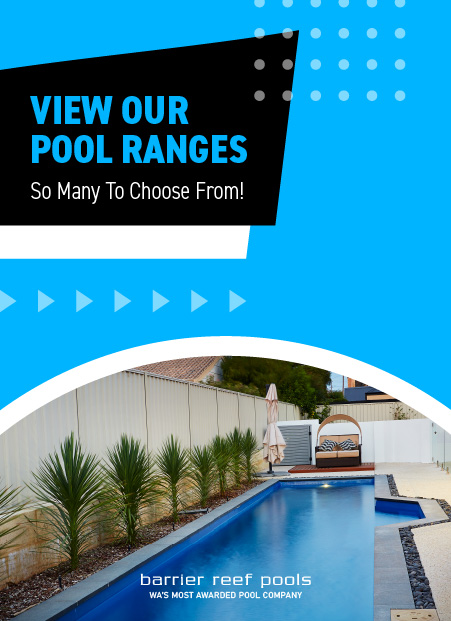Owning a pool is synonymous with relaxation, fun, and outdoor enjoyment. But ensuring your pool area is both aesthetically pleasing and functional requires careful planning, particularly when it comes to choosing the right pavers. The pavers you select can significantly impact the look, safety, and maintenance of your poolside. This comprehensive guide will help homeowners make informed decisions by exploring various paver options, essential considerations, and installation tips. Let's dive in!
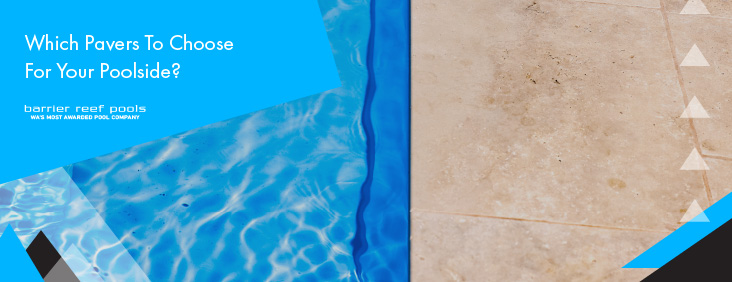
Why Choosing the Right Poolside Pavers Matters
Your pool area is more than just a place to swim; it’s a focal point for gatherings, relaxation, and outdoor living. Selecting the right pavers enhances the overall appeal and ensures safety and durability. With numerous options available, making the best choice can seem overwhelming. This guide will demystify the process, offering valuable insights into different types of pavers, factors to consider, and installation tips to create a stunning and functional poolside environment.
Understanding the Different Types of Pool Pavers
Concrete Pavers
Concrete pavers are a popular choice for pool areas due to their versatility and affordability. They come in a wide range of shapes, sizes, and colours, making it easy to match any design aesthetic. Concrete pavers are also highly durable and can withstand heavy foot traffic and harsh weather conditions. Additionally, their non-slip surface makes them a safe option for wet areas.
Natural Stone Pavers
Natural stone pavers, such as travertine, limestone, and sandstone, bring a timeless elegance to poolside spaces. Each stone type offers unique characteristics, from the earthy tones of sandstone to the luxurious finish of marble. These pavers are not only visually appealing but also highly durable and weather-resistant. However, they can be more expensive than other options and may require sealing to maintain their appearance.
Porcelain Pavers
Porcelain pavers are gaining popularity for their sleek appearance and exceptional durability. They are resistant to water, stains, and fading, making them an excellent choice for pool areas. Available in various designs, including wood and stone textures, porcelain pavers can mimic the look of natural materials without the associated maintenance. Their slip-resistant surface ensures safety around the pool.
Rubber Pavers
Rubber pavers are an eco-friendly option made from recycled materials. They offer excellent slip resistance and cushioning, making them a safe choice for families with children. Rubber pavers are also easy to install and maintain, and they come in various colours and patterns to suit different design preferences. However, they may not have the same aesthetic appeal as natural stone or porcelain pavers.
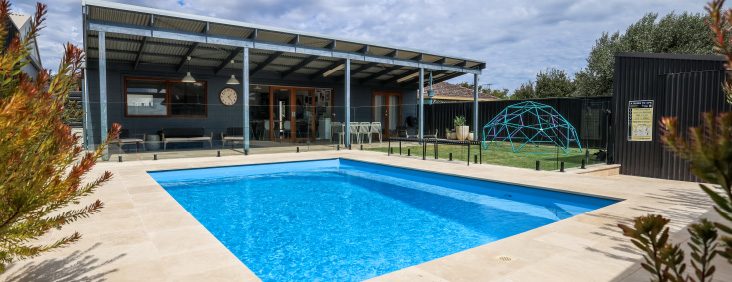
Factors to Consider When Choosing Pool Pavers
Aesthetics
The visual impact of your poolside pavers should complement your home’s overall design. Consider the colour scheme, texture, and style of your home when selecting pavers. For example, natural stone pavers may suit a traditional or rustic home, while sleek porcelain pavers could enhance a modern, minimalist design.
Durability
Poolside pavers must endure constant exposure to water, sunlight, and foot traffic. Choose materials known for their durability, such as concrete, natural stone, or porcelain. These options are designed to withstand the elements without deteriorating quickly.
Safety
Safety is paramount around the pool. Opt for pavers with slip-resistant surfaces to prevent accidents, especially when the area is wet. Additionally, consider pavers with heat-reflective properties to keep the surface cooler underfoot, reducing the risk of burns on hot summer days.
Maintenance
Low-maintenance pavers save time and effort in the long run. Concrete and porcelain pavers are generally easy to clean and require minimal upkeep. Natural stone may need periodic sealing to protect against stains and weathering. Rubber pavers are also low-maintenance, requiring only occasional cleaning.
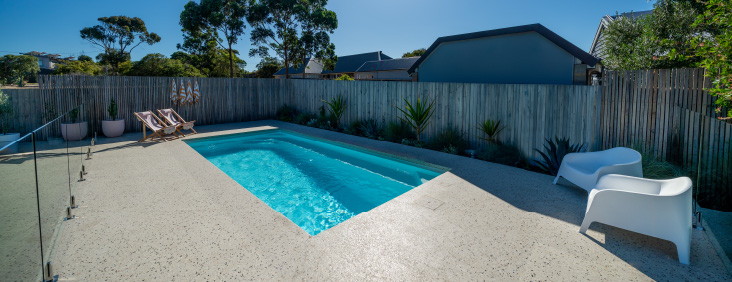
The Process of Paver Installation for Pool Areas
Preparation of the Area
Proper preparation is crucial for a successful paver installation. Start by clearing the area and ensuring a stable base. This may involve excavating the ground, adding a layer of gravel for drainage, and compacting the soil to create an even surface.
Paver Selection and Layout
Select your pavers based on the factors discussed earlier. Plan the layout carefully, considering the shape and size of the pool area. A well-thought-out design enhances the visual appeal and functionality of the space.
Installation Techniques and Best Practices
Begin by laying a sand or mortar bed to provide a stable foundation for the pavers. Place the pavers according to your planned layout, ensuring they are level and evenly spaced. Use a rubber mallet to tap the pavers into place and fill the gaps with sand or grout to secure them.
Maintenance Guidelines for Longevity
To extend the lifespan of your poolside pavers, follow these maintenance tips:
- Regularly sweep and clean the surface to remove debris and prevent stains. Using a soft-bristle brush can help get rid of dirt without scratching the pavers.
- Promptly address any stains or spills to avoid permanent marks. For organic stains like leaves or bird droppings, use a mild detergent and water to clean the area.
- Reapply sealant to natural stone pavers as needed to protect against weathering. This not only enhances the colour and appearance but also adds a protective layer against moisture and UV rays.
- Check for loose or damaged pavers and repair them promptly to maintain a safe surface. If you notice any unevenness, consider re-leveling the area to prevent tripping hazards. Regular inspections can help catch issues before they become major problems.
Conclusion
Choosing the right pavers for your poolside area is a significant decision that impacts both aesthetics and functionality. The selection process can be overwhelming due to the variety of materials available, including concrete, natural stone, and porcelain. By understanding the different types of pavers, such as their texture, colour, and finish, and considering essential factors like durability, safety (especially slip resistance), and maintenance requirements, you can create a beautiful and lasting poolside environment. It’s also crucial to consider the climate of your region and how it might affect the longevity and performance of your chosen pavers.
Following best practices for installation, such as ensuring proper drainage and using high-quality adhesives or sealants, will further enhance the durability of your poolside area. Take the time to explore your options, compare prices, and consult with professionals if needed to ensure you make the best choice for your space. Happy paving!
Owning a pool is synonymous with relaxation, fun, and outdoor enjoyment. But ensuring your pool area is both aesthetically pleasing and functional requires careful planning, particularly when it comes to choosing the right pavers. The pavers you select can significantly impact the look, safety, and maintenance of your poolside. This comprehensive guide will help homeowners make informed decisions by exploring various paver options, essential considerations, and installation tips. Let's dive in!
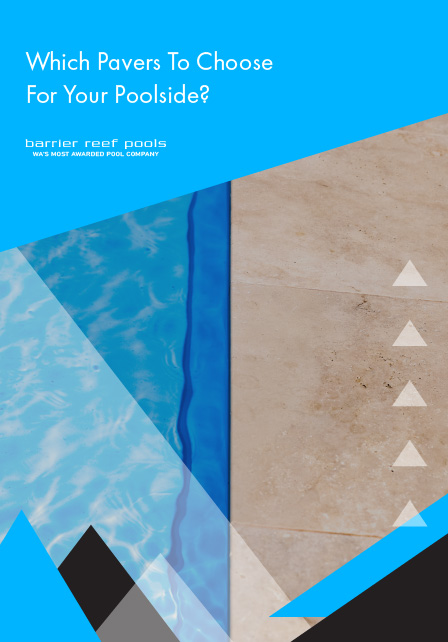
Why Choosing the Right Poolside Pavers Matters
Your pool area is more than just a place to swim; it’s a focal point for gatherings, relaxation, and outdoor living. Selecting the right pavers enhances the overall appeal and ensures safety and durability. With numerous options available, making the best choice can seem overwhelming. This guide will demystify the process, offering valuable insights into different types of pavers, factors to consider, and installation tips to create a stunning and functional poolside environment.
Understanding the Different Types of Pool Pavers
Concrete Pavers
Concrete pavers are a popular choice for pool areas due to their versatility and affordability. They come in a wide range of shapes, sizes, and colours, making it easy to match any design aesthetic. Concrete pavers are also highly durable and can withstand heavy foot traffic and harsh weather conditions. Additionally, their non-slip surface makes them a safe option for wet areas.
Natural Stone Pavers
Natural stone pavers, such as travertine, limestone, and sandstone, bring a timeless elegance to poolside spaces. Each stone type offers unique characteristics, from the earthy tones of sandstone to the luxurious finish of marble. These pavers are not only visually appealing but also highly durable and weather-resistant. However, they can be more expensive than other options and may require sealing to maintain their appearance.
Porcelain Pavers
Porcelain pavers are gaining popularity for their sleek appearance and exceptional durability. They are resistant to water, stains, and fading, making them an excellent choice for pool areas. Available in various designs, including wood and stone textures, porcelain pavers can mimic the look of natural materials without the associated maintenance. Their slip-resistant surface ensures safety around the pool.
Rubber Pavers
Rubber pavers are an eco-friendly option made from recycled materials. They offer excellent slip resistance and cushioning, making them a safe choice for families with children. Rubber pavers are also easy to install and maintain, and they come in various colours and patterns to suit different design preferences. However, they may not have the same aesthetic appeal as natural stone or porcelain pavers.
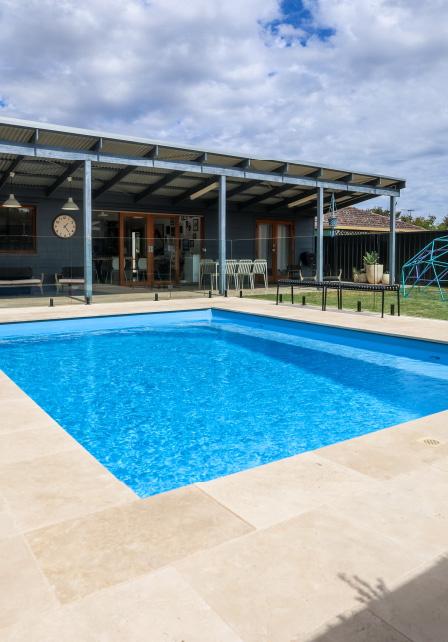
Factors to Consider When Choosing Pool Pavers
Aesthetics
The visual impact of your poolside pavers should complement your home’s overall design. Consider the colour scheme, texture, and style of your home when selecting pavers. For example, natural stone pavers may suit a traditional or rustic home, while sleek porcelain pavers could enhance a modern, minimalist design.
Durability
Poolside pavers must endure constant exposure to water, sunlight, and foot traffic. Choose materials known for their durability, such as concrete, natural stone, or porcelain. These options are designed to withstand the elements without deteriorating quickly.
Safety
Safety is paramount around the pool. Opt for pavers with slip-resistant surfaces to prevent accidents, especially when the area is wet. Additionally, consider pavers with heat-reflective properties to keep the surface cooler underfoot, reducing the risk of burns on hot summer days.
Maintenance
Low-maintenance pavers save time and effort in the long run. Concrete and porcelain pavers are generally easy to clean and require minimal upkeep. Natural stone may need periodic sealing to protect against stains and weathering. Rubber pavers are also low-maintenance, requiring only occasional cleaning.
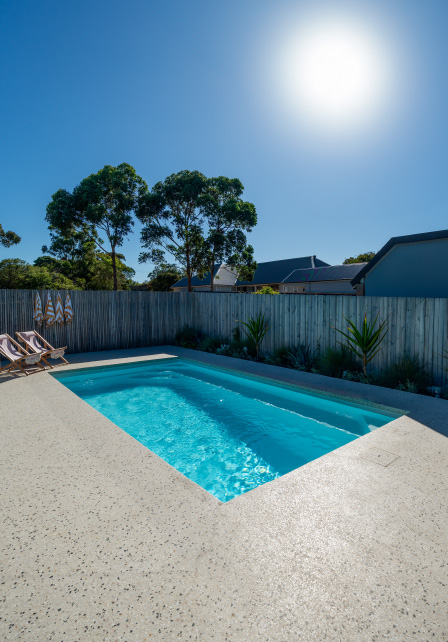
The Process of Paver Installation for Pool Areas
Preparation of the Area
Proper preparation is crucial for a successful paver installation. Start by clearing the area and ensuring a stable base. This may involve excavating the ground, adding a layer of gravel for drainage, and compacting the soil to create an even surface.
Paver Selection and Layout
Select your pavers based on the factors discussed earlier. Plan the layout carefully, considering the shape and size of the pool area. A well-thought-out design enhances the visual appeal and functionality of the space.
Installation Techniques and Best Practices
Begin by laying a sand or mortar bed to provide a stable foundation for the pavers. Place the pavers according to your planned layout, ensuring they are level and evenly spaced. Use a rubber mallet to tap the pavers into place and fill the gaps with sand or grout to secure them.
Maintenance Guidelines for Longevity
To extend the lifespan of your poolside pavers, follow these maintenance tips:
- Regularly sweep and clean the surface to remove debris and prevent stains. Using a soft-bristle brush can help get rid of dirt without scratching the pavers.
- Promptly address any stains or spills to avoid permanent marks. For organic stains like leaves or bird droppings, use a mild detergent and water to clean the area.
- Reapply sealant to natural stone pavers as needed to protect against weathering. This not only enhances the colour and appearance but also adds a protective layer against moisture and UV rays.
- Check for loose or damaged pavers and repair them promptly to maintain a safe surface. If you notice any unevenness, consider re-leveling the area to prevent tripping hazards. Regular inspections can help catch issues before they become major problems.
Conclusion
Choosing the right pavers for your poolside area is a significant decision that impacts both aesthetics and functionality. The selection process can be overwhelming due to the variety of materials available, including concrete, natural stone, and porcelain. By understanding the different types of pavers, such as their texture, colour, and finish, and considering essential factors like durability, safety (especially slip resistance), and maintenance requirements, you can create a beautiful and lasting poolside environment. It’s also crucial to consider the climate of your region and how it might affect the longevity and performance of your chosen pavers.
Following best practices for installation, such as ensuring proper drainage and using high-quality adhesives or sealants, will further enhance the durability of your poolside area. Take the time to explore your options, compare prices, and consult with professionals if needed to ensure you make the best choice for your space. Happy paving!

